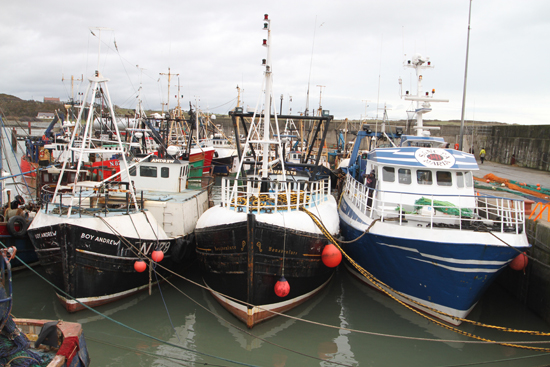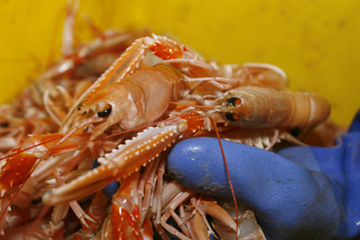At the Brussels EU Fisheries Summit this week on 15-16 December 2014, the Council reached agreement on the 2015 fishing opportunities for certain fish and shellfish stocks in EU and non-EU waters for 2015.
Local Northern Ireland fishing chief Dick james has commented on the results as a “mixed bag from Brussels.”
Council President Martina Maurizio, Minister for Agriculture, Food and Forestry, said: “We have reached a balanced compromise that allows the sustainable use of fisheries resources, in line with the key pillars of the new Common Fisheries Policy (CFP)”.
The CFP is a framework to managing the various European fishing fleets and for conserving fish stocks giving the EU fleets equal access to EU waters and fishing grounds and allows fishermen to compete fairly.
[caption id="attachment_47342" align="aligncenter" width="550"] Prawn trawlers in Ardglass harbour.[/caption]
Prawn trawlers in Ardglass harbour.[/caption]
Stocks may be renewable, but they are finite. Some of these fishing stocks, however, are being overfished. As a result, EU countries have taken action to ensure the European fishing industry is sustainable and does not threaten the fish population size and productivity over the long term.
The CFP was first introduced in the 1970’s and went through successive updates, the most recent of which took effect on 1 January 2014.
The CFP aims to ensure that fishing is environmentally, economically and socially sustainable and that it provides a source of healthy food for EU citizens. Its goal is to foster a dynamic fishing industry and ensure a fair standard of living for fishing communities.
Although it is important to maximise catches, there must be limits. Fishing fleets need to make sure that fishing practices do not harm the ability of fish populations to reproduce. The current policy stipulates that between 2015 and 2020 catch limits should be set that are sustainable and maintain fish stocks in the long term. However, there is much debate over scientific data and information of fish stocks making accurate decision-making on quotas very difficult.
The new changes will apply from 1 January 2015.
NIFPO Chief Comments On Brussels Summit
[caption id="attachment_33455" align="alignright" width="360"] The prawn quota for 2015 has received a welcome increase of 3%.[/caption]
The prawn quota for 2015 has received a welcome increase of 3%.[/caption]
NIFPO Chief Executive Dick James explained: “Prior to the Fisheries Summit, the Commission were looking at a 14% reduction in nephrops (prawns), but we ended up with a 3% increase which was very welcome so we are up on last year on our main species quota.
“However, the down side is we have seen a 7% decrease in the Clyde quota. Quite a number of our County Down boats would fish in the Clyde area in the winter as the fishing opportunities drop off sharply from September to April in the Irish Sea locally. Also the Clyde is more sheltered from adverse weather.
“The haddock quota was rolled over again this year which is fine, but the cod quota is just a disaster. They just would not listen to anyone on this and we basically have a 20% cut. There are some vessels in the North that fish in Irish waters and they will find it slightly more difficult in areas such as the South East fishing for haddock and whiting.
“But significantly, the hake quota is up 10% for the Irish Sea which means we can if necessary trade this high value fish quota for nephrops at the tail end of the season.
“There are fish out there if the local fishermen press for them. The opportunity is there.
“Overall, we have lost in effect the equivalent of of 207 tonnes and will make things tighter, but a least the bulk of the fishermen’s earnings from prawns is reasonably protected by the small 3% increase in quota,” added Mr James.
]]>
























